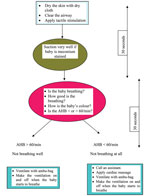7.4.9 Evaluate the baby during ventilation
The best sign of good ventilation and improvement in the baby’s condition is an increase in heart rate to more than 100 beats/minute.
What other change would you expect to see in the baby while you are ventilating it, if the resuscitation is going well?
You would expect to see the baby’s skin colour change from bluish or very pale, to a healthier pinkish colour. You may also see the baby begin to move a little bit, beginning to flex its limbs and look less floppy.
When you stop ventilating for a moment, is the baby capable of spontaneous breathing or crying? These are good signs. Many babies recover very quickly after a short period of ventilation, but keep closely monitoring the baby until you are sure it is breathing well on its own.
If the baby remains weak or is having irregular breathing after 30 minutes of resuscitation, refer the mother and baby urgently to a health centre or hospital where they have facilities to help babies who are having difficulty breathing. Go with them and keep ventilating the baby all the way. Make sure it is kept warm at all times. Newborns easily lose heat and this could be fatal in a baby that can’t breathe adequately on its own.
Figure 7.15 summarises the steps in newborn resuscitation which you have learned in Section 7.4.
7.4.8 Ventilate at 40 breaths per minute

